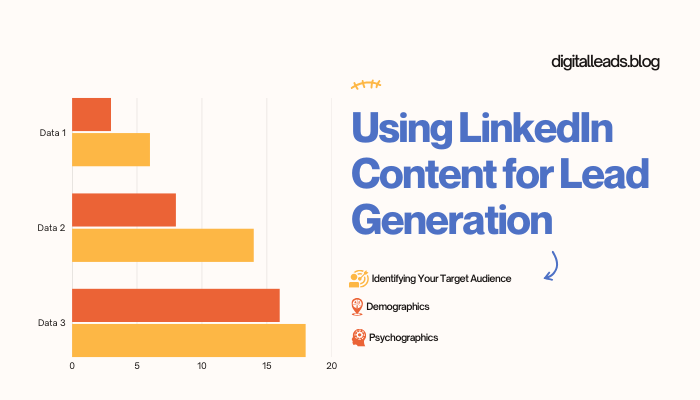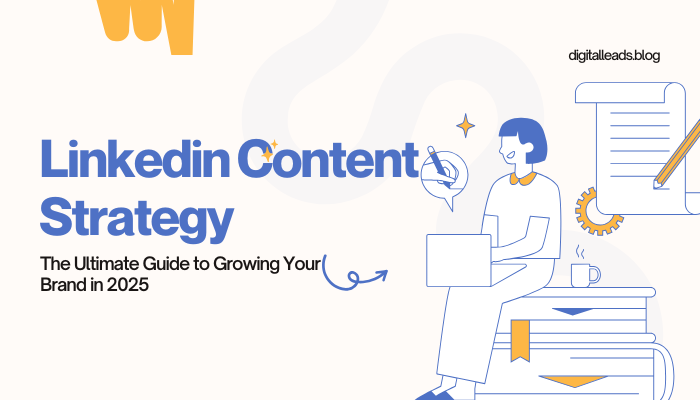When it comes to professional networking and B2B marketing, one platform rules them all — LinkedIn. But just showing up is not enough these days. The real magic happens when you’ve got a solid LinkedIn content strategy that actually speaks to people, earns trust, and( yep) drives real results.
Whether you’re a solo consultant, a scrappy startup founder, or a corporate marketing lead juggling five tools and a caffeine addiction, this guide is for you. We’re going deep into how to craft a content strategy for LinkedIn that gets noticed, sparks conversations, and helps you grow without feeling like you’re forcing it.
What Is a LinkedIn Content Strategy (and Why You Need One)?
Okay, so what’s a LinkedIn content strategy anyway?
In plain terms, it’s your game plan for what you’ll post, how often, who you’re talking to, and why you’re even bothering. Sounds simple, right? But without a plan, most people just kinda post random stuff… and wonder why nothing happens.
Here’s the deal: LinkedIn isn’t about posting to look busy. It’s about showing up with intent. You want your posts to either educate, inspire, or solve real-world problems for your audience. No fluff. No filler.
Honestly, if you’re just posting because you “should,” you might be wasting your time. With a strategy, you actually start building a real presence, credibility, and yeah — some leads, too.

Why LinkedIn Deserves a Unique Content Strategy
LinkedIn isn’t like Instagram. It’s not TikTok. Heck, it’s not even Twitter.
It’s full of people who are there for a reason: they want to grow their careers, learn something useful, or meet folks who can help them solve a problem. That means your LinkedIn content strategy needs to be way more thoughtful and intentional.
Instead of trying to “go viral,” focus on being valuable. And maybe, once in a while, funny. But only if you’re actually funny.
If you’re interested in how to generate B2B leads effectively on LinkedIn, check out our full guide on LinkedIn Lead Generation for B2B.
The Core Pillars of a Powerful LinkedIn Content Strategy
1. Define Your Objective
So, what’s the end goal here?
- Are you trying to build a personal brand?
- Attract inbound leads?
- Get invited to speak at events?
- Build a hiring pipeline?
Each goal totally shifts how you’ll write, what you’ll post, and even how often you should show up.
For example, if you’re aiming for leads, your content will focus more on solving problems and sharing case studies. If you’re building authority, you might lean into thought leadership and industry insights.
And hey, don’t overthink it. Start with one goal and let it evolve.
2. Know Your Audience Deeply
This is where most people mess up.
If you’re not clear on who you’re talking to, your content will feel scattered. Or worse, like it’s meant for no one at all.
Use polls, comment replies, or just honest conversations to figure out who your ideal audience is. Are they marketers? Founders? HR leaders? What do they actually care about?
Build your LinkedIn content strategy for business around them, not you.
3. Mix Your Content Formats
Variety isn’t just the spice of life — it’s also how you stay interesting on LinkedIn.
Play around with:
- Text-only posts: Great for quick stories or sharp insights.
- Carousels (PDFs): People love a good swipe-through.
- Videos: Raw, imperfect ones work best. Seriously.
- Polls: Quick engagement, easy market research.
- Images/Memes: Tastefully done, they grab attention.
You don’t have to do them all. Just find a mix that feels sustainable.
4. Create a Consistent Posting Schedule
Let’s be honest — the algorithm rewards people who show up. But that doesn’t mean you need to post every single day (unless you want to).
Here’s a simple weekly format:
- Monday: Share a lesson or useful tip.
- Wednesday: Tell a personal story with a business angle.
- Friday: Engagement bait — a poll, a question, a bold take.
Just start with 3 days a week and grow from there. You don’t need to be a content machine. You just need to show up consistently.
Crafting High-Impact LinkedIn Content
Hook With the First Three Lines
LinkedIn cuts off your post after the third line, so your hook really matters.
Examples:
- “I made $50K from a single LinkedIn post. No ad spend.”
- “Nobody talks about how lonely remote work can get…”
- “Most content advice on LinkedIn? Honestly, it’s garbage. Here’s why.”
You want to make people curious enough to click “…see more.” Simple as that.
Offer Real Value
This is the meat of your content. The part where you show people, “Hey, I actually know what I’m talking about.”
Give away frameworks, templates, hard-won lessons. Be generous.
Honestly, if you’re holding back your best stuff, your content won’t convert. The best LinkedIn content creation makes people want to work with you.
Use CTAs That Invite Engagement
Always end with something that keeps the conversation going:
- “What’s your take on this?”
- “Have you seen this work in your space?”
- “Want the full checklist? Drop a ‘yes’ below.”
More engagement = more reach. That’s just how it works.
Personal Profiles vs Company Pages: Where Should You Post?
This is a question that comes up all the time.
Personal Profile Pros:
- Way more engagement
- Feels more authentic
- Builds personal trust
Company Page Pros:
- Good for brand consistency
- Supports paid ads
- Showcases team wins, events, etc.
My honest take? Use your personal profile for LinkedIn content marketing and thought leadership. Use your company page for credibility and promotion.

Using LinkedIn Content for Lead Generation
This part’s important.
Your LinkedIn content strategy can absolutely bring in leads, but you’ve got to play the long game. Think of it like dating. You don’t propose on the first post.
Here’s the flow:
Top-of-Funnel:
- Tips
- Educational stuff
- Industry trends
Middle-of-Funnel:
- Case studies
- Pain-point posts
- “Here’s how we solved X for Y client”
Bottom-of-Funnel:
- Testimonials
- Direct offers
- Free calls, DMs, or guides
Show up, deliver value, earn trust — then make the ask.
How to Measure & Optimize Your LinkedIn Content Strategy
Alright, time to get nerdy for a sec.
Look at:
- Impressions (reach)
- Engagement (likes, comments, reposts)
- Profile views (are people curious about you?)
- DMs and leads (are conversations starting?)
Use LinkedIn’s built-in analytics or tools like Shield to track what’s working.
And don’t stress if a post flops. It happens to everyone. Just keep iterating.
To help you dive deeper into tracking and optimizing your LinkedIn performance, you can refer to LinkedIn’s Analytics guide for more details on how to leverage their built-in tools effectively.
Common LinkedIn Content Mistakes to Avoid
Real quick, let’s cover a few things to dodge:
- Sounding like a resume
- Posting only about your wins
- Never telling stories
- Using corporate jargon
- Trying to be perfect
LinkedIn isn’t about perfection. It’s about connection. Write like a human.
Real Examples: LinkedIn Content Strategy in Action
Want some inspo?
Justin Welsh
Built a solo business to 7-figures by posting daily, sharing frameworks, and being super consistent.
Amanda Natividad
Shares behind-the-scenes marketing content. Personal, sharp, and highly relatable.
Lavender AI’s Team
Their whole crew posts. Great mix of humor, product insights, and helpful content. A+ LinkedIn content marketing.
Conclusion: Your LinkedIn Content Strategy Starts Now
Here’s the truth: You don’t need a content team or fancy graphics. You need a clear message, a plan, and the courage to start.
Your LinkedIn content strategy doesn’t have to be perfect. It just has to be real.
Show up. Share what you know. Talk to your audience like they’re people, not leads.
Because honestly? That’s what makes content convert.
FAQ Section for LinkedIn Content Strategy
Q1: What is the best content strategy for LinkedIn?
A successful LinkedIn content strategy includes consistent posting, audience engagement, diverse content types (text, video, carousels), and regular performance analysis to optimize what resonates most with your audience.
Q2: How often should I post on LinkedIn for best results?
Ideally, post 3–5 times per week. Consistency is key, but quality matters more than quantity—focus on value-packed content that sparks engagement.
Q3: What kind of content performs well on LinkedIn?
Posts that are educational, relatable, and authentic tend to perform best—think how-to tips, personal success stories, industry insights, and opinion pieces with a strong hook and CTA.
Q4: Is LinkedIn content strategy different for personal and business accounts?
Yes. Personal profiles often have better organic reach and human connection, while business pages can boost brand credibility and run ads. An integrated strategy using both is most effective.
Q5: How do I measure LinkedIn content success?
Track engagement rate, reach, impressions, profile views, and conversion actions (DMs, clicks, or leads). LinkedIn analytics and third-party tools can provide in-depth insights.
Q6: Can I automate my LinkedIn content strategy?
Yes, with tools like Buffer, Taplio, and Hootsuite, you can schedule posts and monitor performance, but engagement should still be handled manually to maintain authenticity.










